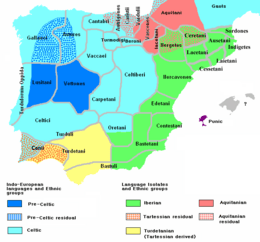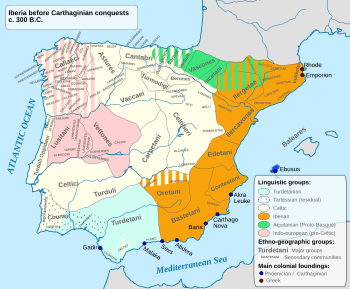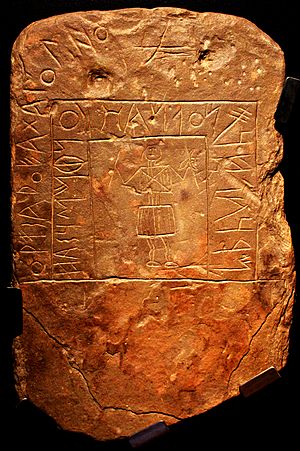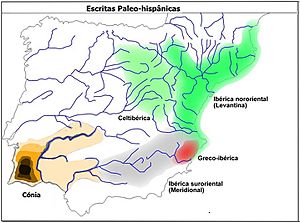Cynetes facts for kids
The Cynetes or Conii were an ancient people. They lived in the southern parts of what is now Portugal and Spain. This was before the 6th century BCE. Their land included today's Algarve and Lower Alentejo regions of Portugal. It also covered parts of the Badajoz, Córdoba, and Ciudad Real in Spain. Later, this area became part of the Roman province called Lusitania. Ancient stories say their first kings were Gargoris and Habis.
Contents
What Does Their Name Mean?
The name Cynetes (or Conii in Latin) likely comes from an old language called Proto-Celtic. The word *kwon meant 'dog'. It is similar to the Greek word kyοn, which also means dog.
Where Did They Come From and Live?
Ancient writers often called the Cynetes by different names. These names were usually Greek or Latin versions of their tribal names. Some examples are ‘Cynetas’, ‘Kunetes’, and ‘Konioi’.
Since the late Bronze Age, the Conii lived in most of the Lower Alentejo and Algarve regions. They also lived in southern Badajoz and parts of Córdoba and Ciudad Real provinces. The Algarve region was even named after them in ancient times, called the Cyneticum. Before the Celtic and Turduli people moved in (around 5th-4th Centuries BC), the Conii also lived further north. Their land reached into upper Alentejo and the Portuguese coast up to the Mondego river valley.
Their Culture
We know about the Conii from things found by archaeologists. They built special burial mounds for their leaders. These mounds contained rich items and stone slabs with writing. This writing is called the ‘Southwest script’ or ‘Tartessian alphabet’. These finds show that the Conii had strong connections with North Africa and the eastern Mediterranean. This contact goes back to the 9th century BC.
Some experts believe the Conii were related to the Ligures, an ancient people from Italy and France. They also seem to be connected to the Aquitanians and the Basques.
Writing in the Tartessian language has been found in the Conii area. This writing is often called the Southwest Paleohispanic script. The ancient writer Herodotus mentioned a people called the Cynesii. He said they were the westernmost people in Europe. He also said they were different from the Celts. It seems these Cynesii were the same as the Conii mentioned by Strabo.
Their Towns
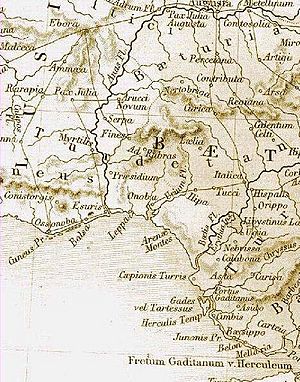
The main city of the Conii was Conistorgis. The name Conistorgis likely meant "City of the Conii" in their language. We don't know exactly where this city was located. Some people think the Roman city of Pax Julia was built on its ruins.
Other important Conii towns were Ipses (Alvor), Cilpe (Cerro da Rocha Branca near Silves), and Ossonoba (near Faro). There was also Balsa (near Tavira), Baesuris (Castro Marim), and Myrtilis (Mértola). An ancient writer named Pomponius Mela said that these towns were small. They had no more than 6,000 people living in them.
From the 4th Century BC, wealthy traders from Phoenicia and Turdetani controlled the trade, fishing, and shipbuilding in these coastal towns. Later, the Carthaginians took over the Cyneticum region. They founded their own colonies there, like Portus Hannibalis and Portus Magonis (Portimão) in the late 3rd Century BC.
Their History
The Conii did not play a big role in the Second Punic War. This was a major war between Rome and Carthage. They were often pressured by Celtic tribes from the north. This might be why they sought protection from powerful groups like Carthage and later Rome.
Around the 3rd Century BC, the Celtici people reached the western Algarve. They started a settlement called Laccobriga (Monte Molião, near Lagos).
In 153 BC, during the Lusitanian Wars against Rome, the city of Conistorgis was captured. It was taken by the Lusitani and their allies, the Vettones. Because of this, the Conii had to switch their loyalty from Rome to the Lusitani. As a result, a Roman general named Quintus Fabius Maximus Servilianus attacked their lands in 141-140 BC.
In 138-137 BC, the Cyneticum region became part of the Roman province of Hispania Ulterior. However, it became a battleground again during the Sertorian Wars. During this war, a Roman leader named Quintus Sertorius captured Conistorgis. In return, the Roman general Quintus Caecilius Metellus Pius attacked the region. He was defeated at the battle of Laccobriga in 78 BC.
Becoming Roman
Between 27 and 13 BC, the Conii people became part of the Roman way of life. Their land was then included in the Roman province of Lusitania.
See also
 In Spanish: Conios para niños
In Spanish: Conios para niños
- History of Portugal
- Prehistoric Iberia
- Conistorgis
- Cyneticum
- Timeline of Portuguese history
- Sefes
- Sertorian Wars
- Southwest Paleohispanic script
- "Tartessian" language (Southwestern or "South-Lusitanian" language)
- Pre-Roman peoples of the Iberian Peninsula


